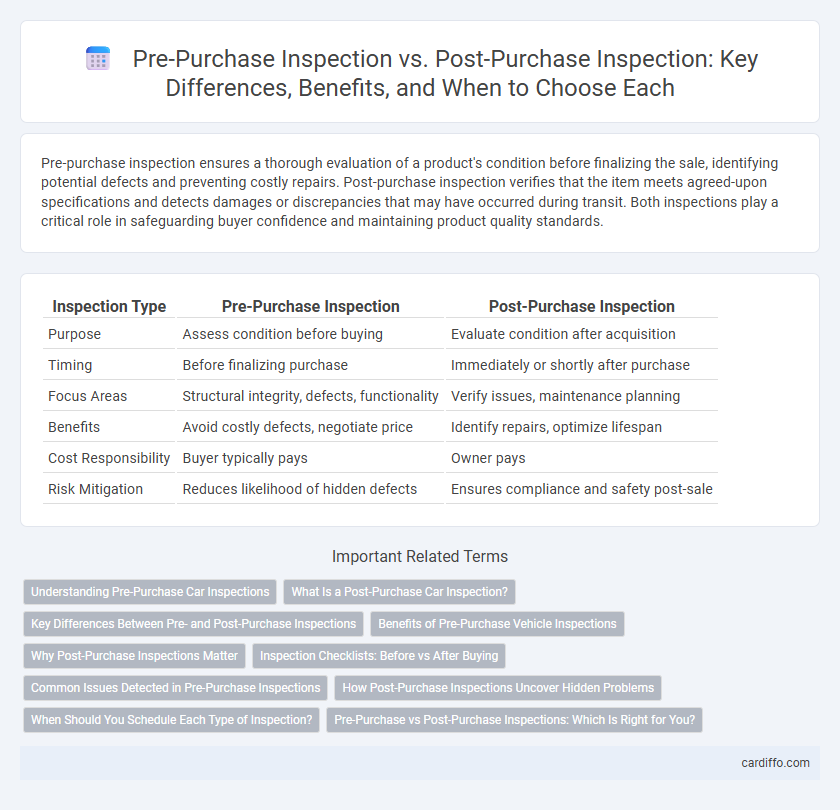Pre-purchase inspection ensures a thorough evaluation of a product's condition before finalizing the sale, identifying potential defects and preventing costly repairs. Post-purchase inspection verifies that the item meets agreed-upon specifications and detects damages or discrepancies that may have occurred during transit. Both inspections play a critical role in safeguarding buyer confidence and maintaining product quality standards.
Table of Comparison
| Inspection Type | Pre-Purchase Inspection | Post-Purchase Inspection |
|---|---|---|
| Purpose | Assess condition before buying | Evaluate condition after acquisition |
| Timing | Before finalizing purchase | Immediately or shortly after purchase |
| Focus Areas | Structural integrity, defects, functionality | Verify issues, maintenance planning |
| Benefits | Avoid costly defects, negotiate price | Identify repairs, optimize lifespan |
| Cost Responsibility | Buyer typically pays | Owner pays |
| Risk Mitigation | Reduces likelihood of hidden defects | Ensures compliance and safety post-sale |
Understanding Pre-Purchase Car Inspections
Pre-purchase car inspections provide buyers with a detailed evaluation of a vehicle's mechanical condition, mileage accuracy, and accident history before finalizing the purchase, reducing the risk of unexpected repairs. Certified mechanics use diagnostic tools and visual checks to assess key components such as the engine, transmission, brakes, and frame integrity. Understanding this inspection helps buyers negotiate better prices and make informed decisions, contrasting with post-purchase inspections that identify issues only after ownership transfer.
What Is a Post-Purchase Car Inspection?
A post-purchase car inspection is a detailed evaluation conducted after buying a vehicle to identify any existing problems or potential issues that were not apparent before the sale. This inspection focuses on assessing the car's mechanical condition, safety features, and overall performance to ensure the buyer's investment is sound. It helps uncover hidden defects, necessary repairs, and maintenance needs, providing peace of mind and protection against unexpected costs.
Key Differences Between Pre- and Post-Purchase Inspections
Pre-purchase inspections focus on evaluating a product or vehicle's condition before finalizing a transaction to identify defects, potential repairs, and verify value. Post-purchase inspections occur after the sale, aiming to assess current status, detect hidden damages, and ensure compliance with warranty or contract terms. The key differences lie in timing, purpose, and impact on negotiation or liability resolution.
Benefits of Pre-Purchase Vehicle Inspections
Pre-purchase vehicle inspections provide buyers with a comprehensive assessment of a car's mechanical condition, identifying potential issues before ownership transfer. This inspection minimizes the risk of costly repairs and unexpected breakdowns by revealing hidden defects or damage. Buyers gain negotiation leverage and increased confidence, ensuring a more informed and secure investment.
Why Post-Purchase Inspections Matter
Post-purchase inspections identify hidden issues that were not evident during the initial sale, ensuring long-term vehicle reliability and safety. These inspections help buyers address warranty claims and maintenance needs more effectively by detecting early signs of wear or damage. Understanding the vehicle's current condition after purchase reduces unexpected repair costs and enhances buyer confidence.
Inspection Checklists: Before vs After Buying
Inspection checklists before buying emphasize verifying structural integrity, functionality, and compliance with safety standards to identify potential defects and negotiate repairs or price adjustments. Post-purchase inspection checklists prioritize maintenance needs, warranty validations, and immediate repairs to ensure optimal performance and avoid long-term damage. Comparing these checklists highlights how pre-purchase inspections focus on risk assessment, while post-purchase inspections target upkeep and durability.
Common Issues Detected in Pre-Purchase Inspections
Pre-purchase inspections commonly detect issues such as engine problems, transmission defects, and signs of previous accident damage that could affect vehicle safety and performance. Inspectors also identify fluid leaks, brake wear, and tire condition to prevent costly repairs and ensure compliance with safety standards. Detecting these issues before purchase helps buyers make informed decisions and avoid unexpected expenses.
How Post-Purchase Inspections Uncover Hidden Problems
Post-purchase inspections reveal hidden problems by thoroughly examining a vehicle's mechanical systems, frame integrity, and electrical components that may have been overlooked during the initial sale. These inspections identify issues such as engine wear, fluid leaks, or prior accident damage that can lead to costly repairs over time. Detecting problems early post-purchase allows buyers to take legal action or negotiate repairs with sellers, protecting their investment and ensuring vehicle safety.
When Should You Schedule Each Type of Inspection?
Schedule a pre-purchase inspection before finalizing any vehicle or property acquisition to identify potential defects and avoid costly repairs. A post-purchase inspection is recommended shortly after acquisition to establish a baseline condition and address any emerging issues promptly. Timely inspections ensure informed decisions and protect your investment from unforeseen problems.
Pre-Purchase vs Post-Purchase Inspections: Which Is Right for You?
Pre-purchase inspections identify potential issues before finalizing a transaction, helping buyers avoid costly repairs and negotiate better prices. Post-purchase inspections assess the condition after acquisition, guiding maintenance priorities and uncovering hidden problems missed initially. Choosing between pre-purchase and post-purchase inspections depends on risk tolerance, budget flexibility, and the asset's condition at the time of sale.
Pre-purchase inspection vs post-purchase inspection Infographic

 cardiffo.com
cardiffo.com